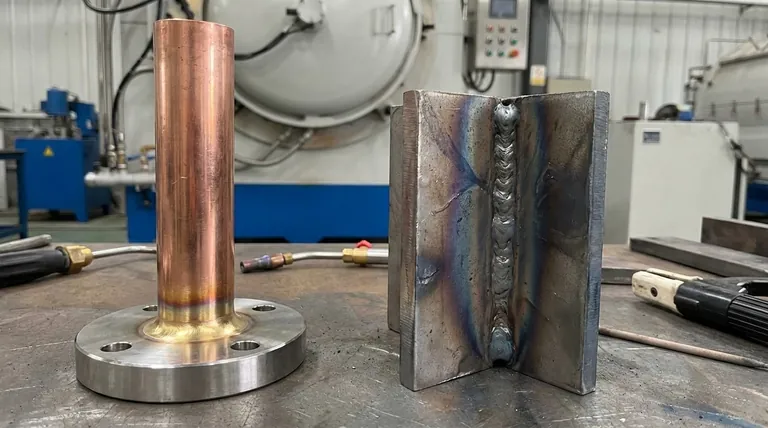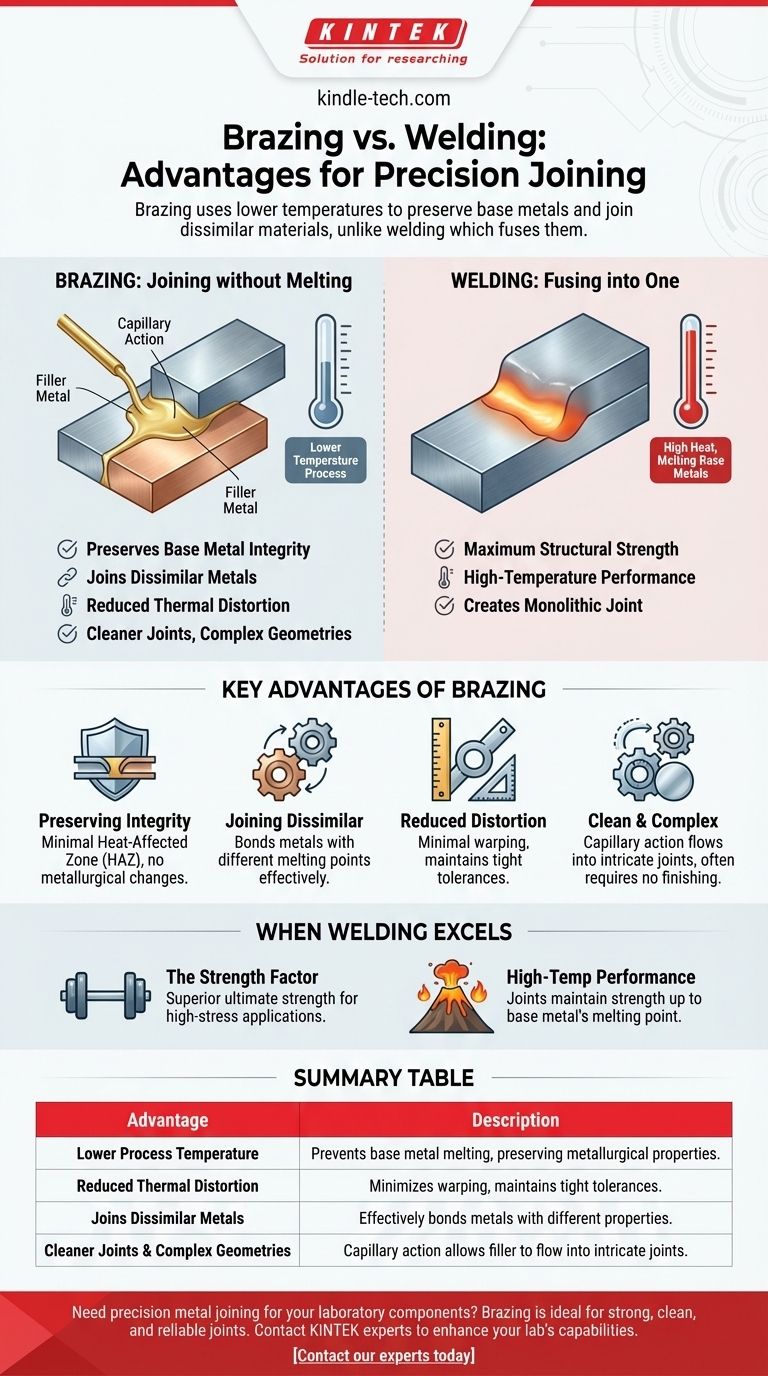At its core, brazing offers significant advantages over welding in applications where preserving the base metals is paramount. Its primary benefits stem from using a much lower process temperature, which prevents the base metals from melting. This results in less thermal distortion, maintains the metallurgical properties of the parent materials, and allows for the successful joining of dissimilar metals.
The fundamental choice between brazing and welding is a choice between joining and fusing. Brazing acts as a high-strength adhesive that bonds metals together without melting them, while welding melts and fuses them into a single, continuous piece. This distinction drives every advantage and trade-off.

The Process: Joining vs. Fusing
How Brazing Works
Brazing is a joining process where a filler metal with a melting point lower than the base metals is heated above its melting point (typically above 840°F / 450°C).
This molten filler is drawn into the tight-fitting gap between the base metals via capillary action. It then solidifies, forming a strong metallurgical bond without ever melting the parts being joined.
How Welding Works
Welding is a fabrication process that fuses materials together. It involves using high heat to melt the base metals, often along with a filler material.
The molten materials mix, cool, and solidify, forming a joint that is a continuous, monolithic structure with the parent metals.
Key Advantages of Brazing
Preserving Base Metal Integrity
Because brazing temperatures are significantly lower than the melting points of the base metals, their fundamental properties are not altered.
This dramatically reduces the size of the Heat-Affected Zone (HAZ), minimizing the risk of thermal stress, cracking, and metallurgical changes. This is a critical advantage when working with heat-sensitive materials or alloys like cast iron.
Joining Dissimilar Metals
Brazing is exceptionally effective at joining metals with vastly different properties and melting points, such as copper to steel or aluminum to copper.
Since the base metals do not need to be melted and fused, their metallurgical incompatibility is not an issue. The filler metal is simply chosen to be compatible with both materials being joined.
Reduced Thermal Distortion
The lower heat input of the brazing process means less thermal expansion and contraction during the joining cycle.
This results in assemblies with minimal distortion, warping, or changes in alignment. It is ideal for precision components where maintaining tight tolerances is essential.
Cleaner Joints and Complex Geometries
Brazing often produces smooth, clean joints that require little to no secondary finishing. Processes like vacuum brazing prevent oxidation entirely, resulting in bright, clean parts straight from the furnace.
Furthermore, the capillary action allows the filler metal to penetrate complex and intricate joints that would be impossible to reach with a welding torch, enabling more sophisticated designs.
Understanding the Trade-offs: When Welding Excels
The Strength Factor
While a properly designed brazed joint is exceptionally strong—often exceeding the strength of the filler metal—a welded joint is typically stronger.
Welding creates a single, continuous piece of metal. For applications under extreme load or high-stress conditions, the monolithic joint created by welding offers superior ultimate strength.
High-Temperature Performance
This is a critical distinction. Welded joints maintain their strength up to the melting point of the base metal itself.
Brazed joints, however, will fail if the service temperature approaches the melting point of the filler metal, which is significantly lower than that of the base metals. For high-temperature applications, welding is the only suitable choice.
Making the Right Choice for Your Application
Your decision should be guided by the specific demands of your project and the properties you need to preserve.
- If your primary focus is joining dissimilar metals or delicate components: Choose brazing for its low-temperature process that preserves base metal integrity.
- If your primary focus is maximum structural strength and high-temperature service: Choose welding for its fused, monolithic joints and superior heat resistance.
- If your primary focus is minimizing distortion and maintaining tight tolerances: Choose brazing to avoid the high thermal stress associated with welding.
- If your primary focus is creating clean, complex joints with minimal finishing: Choose brazing for its ability to flow into intricate gaps and produce aesthetically pleasing results.
By understanding the core difference between joining and fusing, you can confidently select the process that best serves the performance and integrity of your design.
Summary Table:
| Advantage | Description |
|---|---|
| Lower Process Temperature | Prevents base metal melting, preserving metallurgical properties. |
| Reduced Thermal Distortion | Minimizes warping and maintains tight tolerances for precision parts. |
| Joins Dissimilar Metals | Effectively bonds metals with different properties and melting points. |
| Cleaner Joints & Complex Geometries | Capillary action allows filler metal to flow into intricate joints. |
Need precision metal joining for your laboratory components?
Brazing is ideal for creating strong, clean, and reliable joints in sensitive equipment and assemblies. KINTEK specializes in providing advanced thermal processing solutions and expert advice for your laboratory's unique challenges.
Contact our experts today to discuss how brazing can enhance your lab's capabilities and product integrity.
Visual Guide

Related Products
- Vacuum Heat Treat Sintering Brazing Furnace
- Molybdenum Vacuum Heat Treat Furnace
- 2200 ℃ Tungsten Vacuum Heat Treat and Sintering Furnace
- Vacuum Heat Treat Furnace with Ceramic Fiber Liner
- Vacuum Heat Treat Furnace and Levitation Induction Melting Furnace
People Also Ask
- Where are vacuum furnaces used? Essential for High-Purity Heat Treatment in Critical Industries
- What is a vacuum furnace used for? Unlock Purity in High-Temperature Processing
- What is vacuum brazing? The Ultimate Guide to High-Purity, Flux-Free Metal Joining
- What are the different types of brazing welding? A Guide to Choosing the Right Heat Source
- What are vacuum furnaces used for? Unlock Ultimate Material Purity and Performance



















